In part one of our five part series, we examine this years point guard crop strictly by the numbers. In our point guard comparison, we were unable to include Patrick Beverley, since the Ukrainian second division isnt part of our statistical database. However, we are including Rodrigue Beaubois and Nando De Colo, two players whose numbers we didnt have last season when we did this analysis.
Although these numbers aim to put every prospect on a level playing field, it is important to consider their age, level of competition, and often their role when judging the significance of their numbers.
To gain a better understanding of the statistics used, visit the glossary by Noah Libby-Haines. Interested in making your own statistical comparisons? You can do so here.
Note: The blue dots next to the names of the European prospects indicate that the row theyre in are Euroleague statistics. The other column without the dot display their domestic league numbers.
Point Per-40 Minutes Pace Adjusted
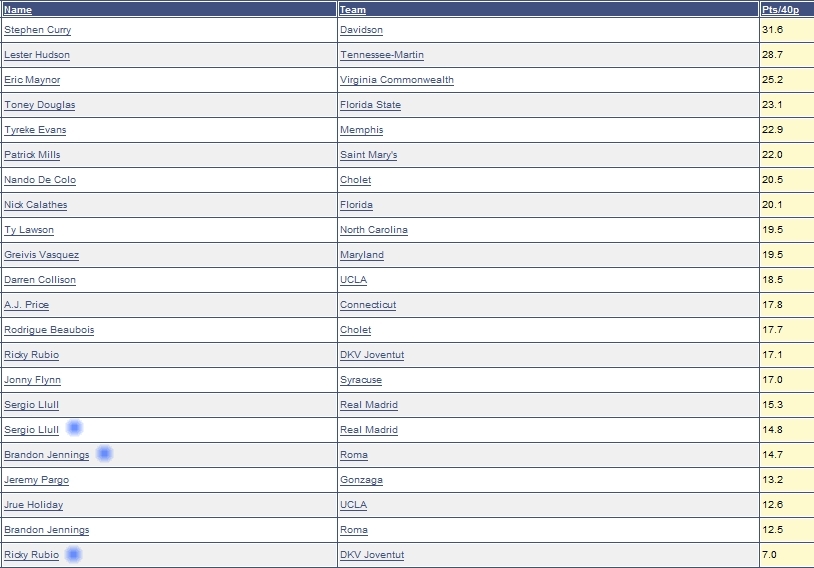
This is a good place to start with the point guard crop, as it helps us understand the role that the player played on his team, and his mentality as a playmaker or scorer.
Lester Hudson couldnt repeat as the top per-40 scorer in our database thanks to Stephen Currys 31.6 point average.
It is unsurprising to see three small school players at the top of our list, since these players are typically asked to do more, and wouldnt be warranting attention if they werent carrying their teams the way they have. Toney Douglas is our first big school name on the list at 23.1, while potential lottery pick Tyreke Evans was just behind him at 22.9 per-40. Nando De Colo is the first international prospect on our list with 20.5 points per-40 in the French League, easily the highest amongst European players. The second highest comes from his teammate Rodrigue Beaubois at 17.7 per-40.
Three probable lottery picks, Ricky Rubio, Brandon Jennings, and Jrue Holiday close out our rankings by falling under 13.0 points per-40. While Jennings and Holiday have their own excuses, Ricky Rubios 7.0 point per-40 tell you a lot more about his wrist injury than his actual play in the Euroleague, as he was playing just a few games with only one hand. Jennings in contrast actually did a slightly better job against better competition, which is notable as well. Holiday's struggles to score at UCLA have been well documented, and surely have to be considered somewhat of a reason for concern.
Three Point Attempts Per-40 Minutes Pace Adjusted
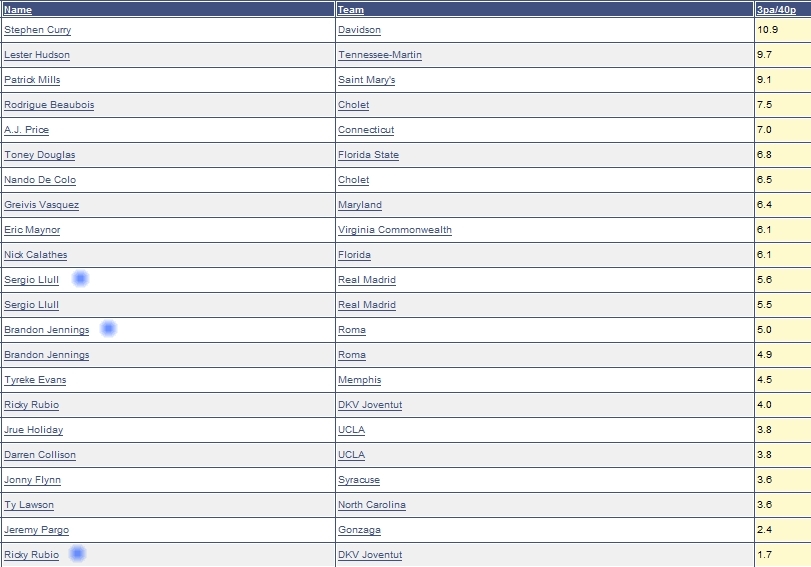
Stephen Currys place in the last category has a lot to do with his place in this one. Curry took almost 11 three-pointers per-40 minutes, a truly overwhelming total. Lester Hudson falls in the same boat, checking in at number two on both lists, while Patrick Mills rounds out the top three here, but didnt make enough of the many threes he attempted to place himself as high on the points per-40 rankings. Rodrigue Beaubois checks in as our first international player at 7.5 per-full contest, which raises some concerns about his shot selection when you consider he only shot 31.7% from deep. The difference in Ricky Rubios attempts in the Euroleague and the ACB tells you how much of a difference a few months of rehab can make. We also find Jonny Flynn and Ty Lawson sitting near the bottom of this list, unsurprising for two guys who handle the ball a great deal and play on good teams with considerably talented wings.
Three Point Attempts Per Field Goal Attempt
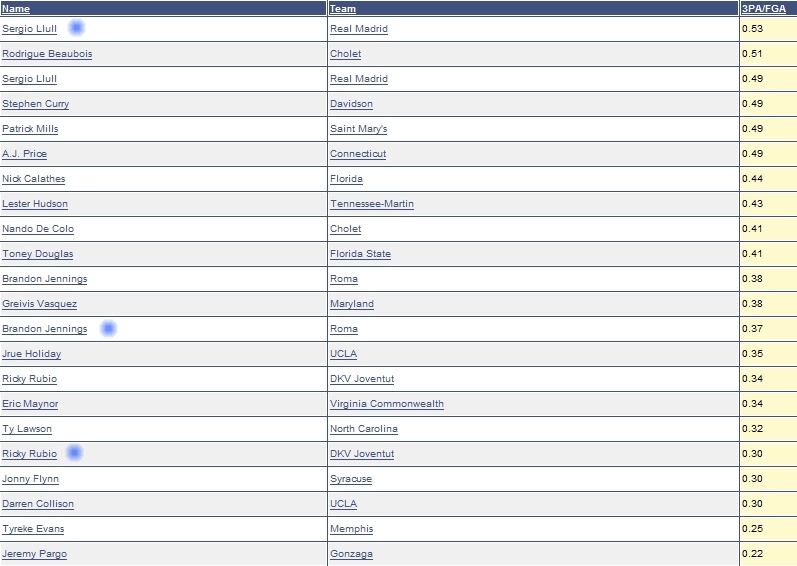
This stat examines how heavily a player relied on the 3-ball to score points, which is also an indicator of the ball-handling ability, athleticism, aggressiveness, or role that could have relegated them to such shots.
Sergio Llull ranks at the top of our list in Euroleague play, which has a lot to do with his role as a spark plug off the bench and often off the ball. He, along with Rodrigue Beaubois, are the only two players to take more shots from beyond the arc than inside it. In stark contrast to Llull, Beaubois isnt as efficient and is much faster, characterizing how he often settled for jumpers when he could have attacked off the bounce.
Stephen Curry, A.J. Price, and Patrick Mills check in a shade under 50%, which says a lot considering two were go-to-guys while the other was a roleplayer on one of the top teams in the country. Price's struggles returning from a torn ACL have been well documented, and it surely manifests itself in this stat.
Tyreke Evans takes the second least three pointers of anyone at .25 per FGA, telling us a lot about what he wants to do with the ball when he's looking to score.
Other players who are deemed to be all that confident in their 3-point shooting also rank near the bottom of this, namely Jonny Flynn, Ricky Rubio and Ty Lawson.
Free Throw Attempts Per-40 Minutes Pace Adjusted
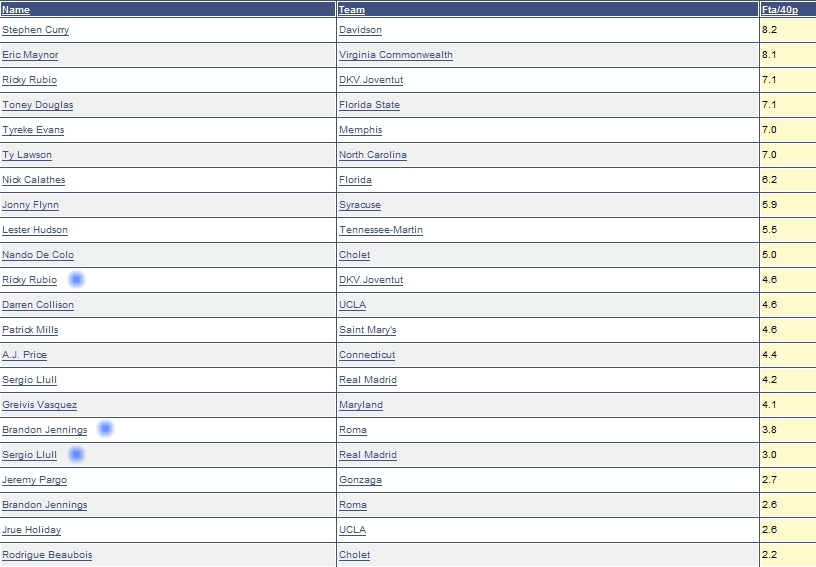
Free throws attempted per-40 minutes is a good statistic to measure the aggressiveness of a player getting to the rim, as well as his athleticism and ball-handling skills.
Stephen Curry and Eric Maynor top our list by a full attempt, indicating just how savvy the pair are when they put the ball on the floor to attack the paint. Though neither player is a great athlete, they certainly compensate effectively. Ricky Rubio falls into the same boat at third, while Tyreke Evans and Ty Lawson use their impressive physical tools to tie for fifth at 7.0 attempts per-40.
Brandon Jennings, in contrast, posted only 2.6 attempts, a highly questionable average for a player with his quickness. Jrue Holiday also falls rather low on our list at 2.6, which is indication of his struggles to beat players off the dribble at the UCLA. He did beat Rodrigue Beauboiss 2.2 soundly, which is a bit discouraging considering how athletic Beaubois is, and how little he seemingly used that.
Nick Calathes isn't deemed to be the quickest or strongest guy in the world, but he still managed to get to the line at a very nice rate, which is impressive. The same can be said for his European counterpart Nando De Colo.
Free Throw Attempts Per Possession
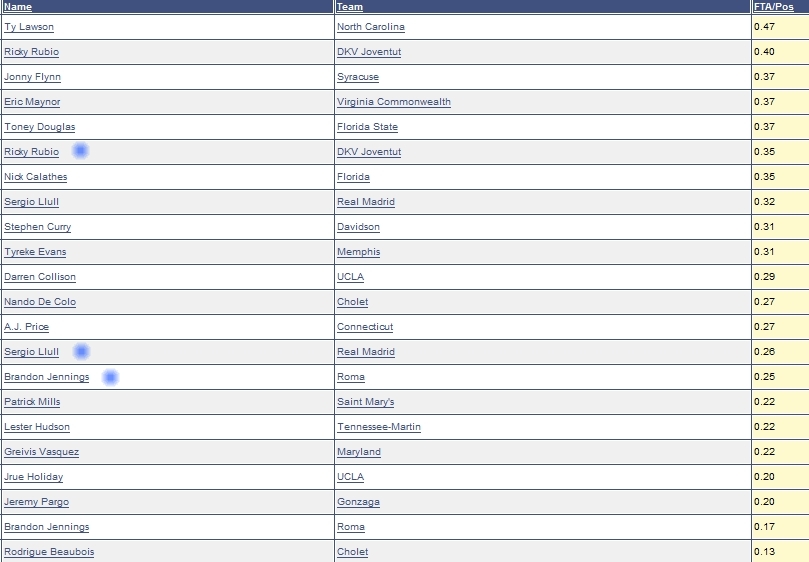
Even though Free Throws Per-40 Minutes Pace Adjusted tells us how much a player attacks in bulk, it doesnt show how much they attack relative to their usage rate. This stat tells that story.
Ty Lawson got to the line on a per possession basis significantly more frequently than anyone on our list at .47 FTA per possession. Ricky Rubio followed him in second at .40 with Jonny Flynn, Eric Maynor, and Toney Douglas not too far behind at .37 attempts on average. Ricky Rubios injured Euroleague play earned him a top-10 spot, which tells you how well he effortless he draws contact in the paint.
On the downside, Brandon Jennings, Jeremy Pargo, and Jrue Holiday didnt get to the line much, nor did Patrick Mills or Lester Hudson. Obviously these guys are taking a lot more jumpers than their counterparts near the top of the list.
True Shooting Percentage
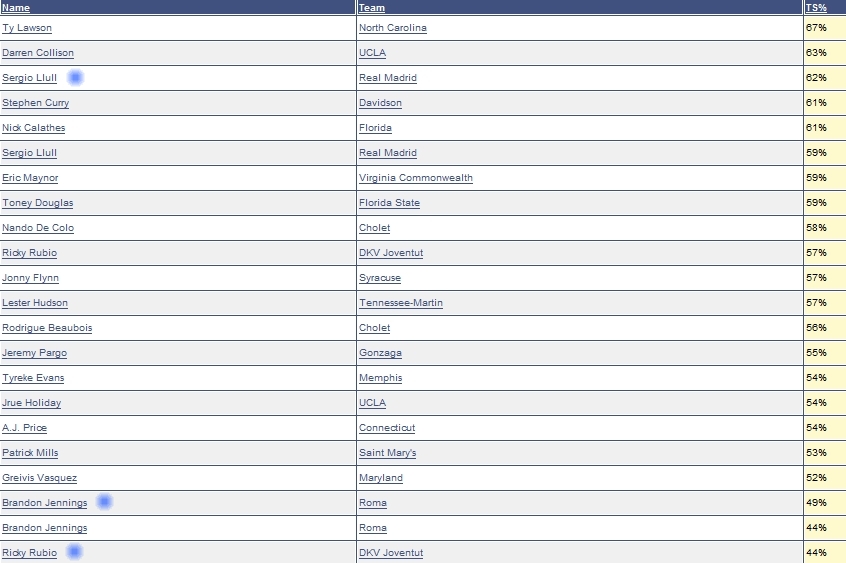
True Shooting Percentage is adjusted to account for what a player adds to their efficiency and team's point total with free throw attempts and 3-pointers. A player who makes 4/10 3-pointers obviously contributes the same amount of points as a player who made 6/10 2-pointers--which doesn't show up in the traditional field goal percentage stat. This stat attempts to adjust for that.
Ty Lawson has the top mark at 67%, an extremely impressive mark which shows just how efficient an all-around player he was for North Carolina.
He was followed by another battle tested guard in Darren Collison, known for his terrific shot-selection and mistake-free style of play. Sergio Llull posts a high mark at 62% in Euroleague play, further indicating his high skill-level, especially when considering the extremely tough level of competition he played in.
The bottom of the list features players who have often been criticized for their decision making skills--Greivis Vasquez, Patrick Mills, and Brandon Jennings. Jrue Holiday and Tyreke Evans also rank on the low-side here.
Assists Per-40 Minutes Pace Adjusted
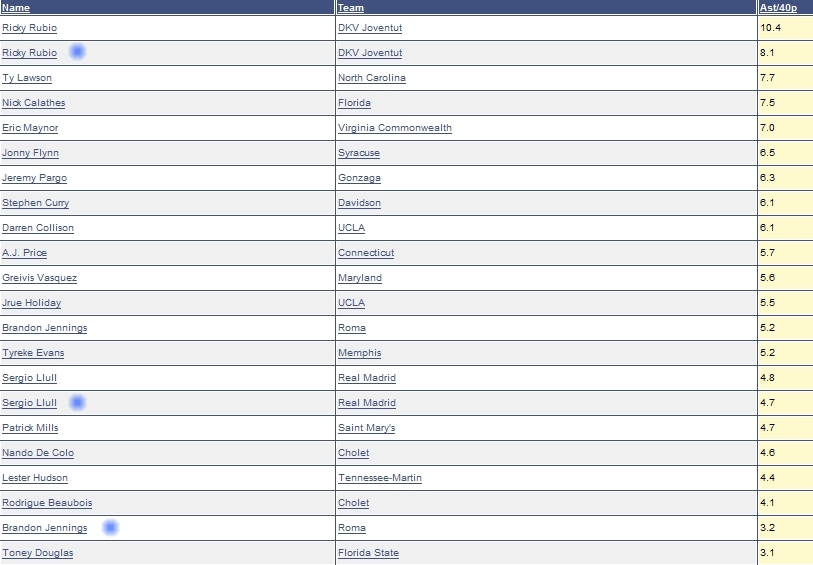
Ricky Rubio posts the two highest marks in this category with his impressive ability to set the table for his teammates. His 10.4 assists per-40 dwarfs Ty Lawsons 7.7 and is simply outstanding for any player, let alone an 18 year old in the second best League in the world. Even his Euroleague numbers are excellent, telling you a lot about how well he got everyone involved while playing essentially one-handed. Maybe he isn't "all hype" after all?
Lawson's status as the best point guard in college basketball this season continues to ring true here.
Nick Calathes checks in at 7.5, which is an accurate indicator of his ability to get others involved, as well as score.
Jrue Holiday, Brandon Jennings, and Tyreke Evans fir right around the middle of our list at 5.2-5.5. Toney Douglas lands in last at 3.1 assists, which supports the conclusion that he is much more of a shooting guard than a point guard at the moment. Similar things might be said about Patrick Mills, Rodrigue Beaubois and Lester Hudson.
Turnovers Per-40 Minutes Pace Adjusted
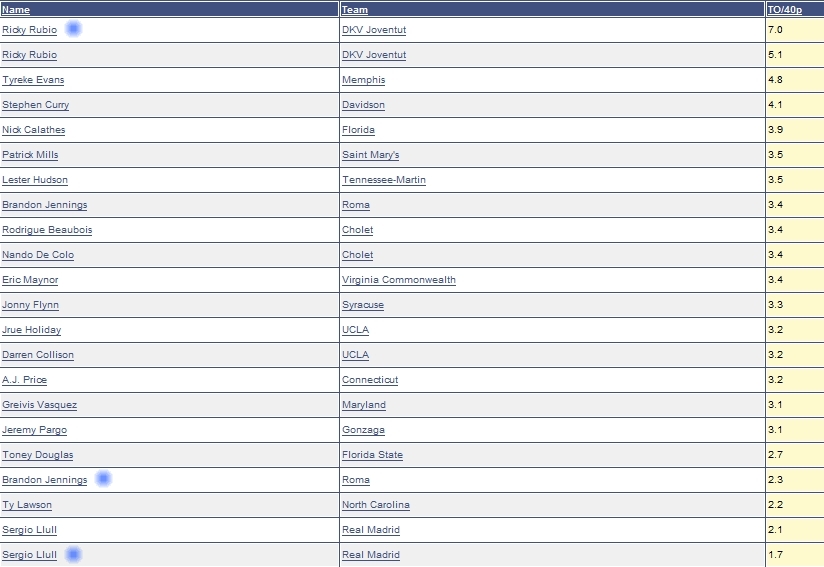
Being an effective playmaker comes with a price in the Euroleague, as we can see from Ricky Rubios extremely high 7.0 turnovers per-40. Considering that he only played 13 minutes per game in just 5 games, we're probably better off looking at his figures in the ACB to get a more accurate indication. Unfortunately he also leads all point guards in that category as well.
Tyreke Evans, Stephen Curry, and Nick Calathes all finish near the top as well, which isnt a shock considering how heavily their teams relied on them as primary ball-handlers this season.
Near the bottom of our list we find Ty Lawson, who continues to absolutely sparkle in virtually every statistical category, and Sergio Lllull, who's mistake-free blend of basketball was a major reason why he was able to see such heavy playing time in the Euroleague and ACB this season.
Assist to Turnover Ratio
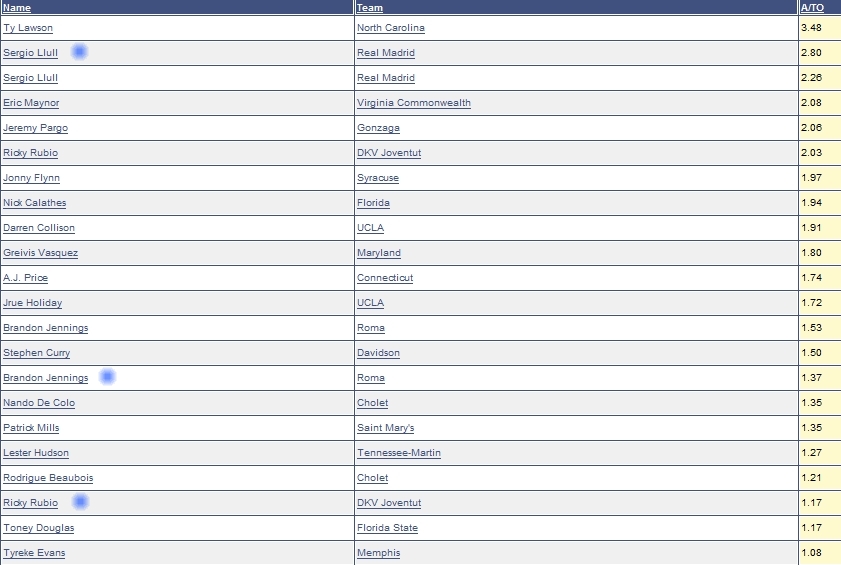
The classic measure of how well a point guard is managing his team, Ty Lawson is head and shoulders above the competition, dishing out 3.48 assists for every time he gives the ball to the opposition. Sergio Llull owns the next two spots, taking care of the ball extremely well more-so than being an aggressive playmaker.
Eric Maynor, Ricky Rubio, and Jeremy Pargo are the three other players over 2.
The lowest totals on our list come from the players most often considered to be more combo guards than pure points-- Tyreke Evans, Toney Douglas, Lester Hudson, and Patrick Mills. Evans turns the ball over almost as often as he tallies assists, which has to be considered somewhat of a concern.
Pure Point Rating
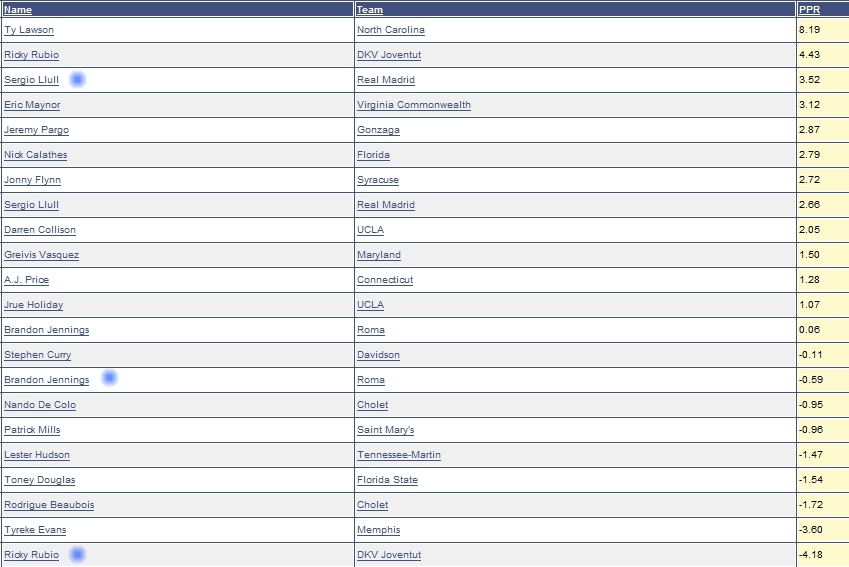
Accounting for the fact that turnovers are statistically worse than assists are positive, and for pace, Jon Hollingers pure point rating builds on the A/TO ratio that many of us use to gauge the efficiency of points guards. This stat backs up the things we learned in our Situational Statistics series: Ty Lawson had a remarkably efficient season. His PPR of 8.19 is almost twice as much as Ricky Rubio's second place effort of 4.43, a pretty large disparity. Sergio Llull comes in third with his Euroleague performance, while Eric Maynor, Jeremy Pargo, Nick Calathes, and Jonny Flynn round out the players over 2.5. On the low end, Stephen Curry lands below 0 at -.11, as do Lester Hudson, Toney Douglas, and Patrick Mills. Tyreke Evans had the lowest PPR amongst college players at -3.6 a very poor mark that has to say something about his ability to shoulder immediate minutes at the point guard position right away.
Rebounds Per-40 Minutes Pace Adjusted
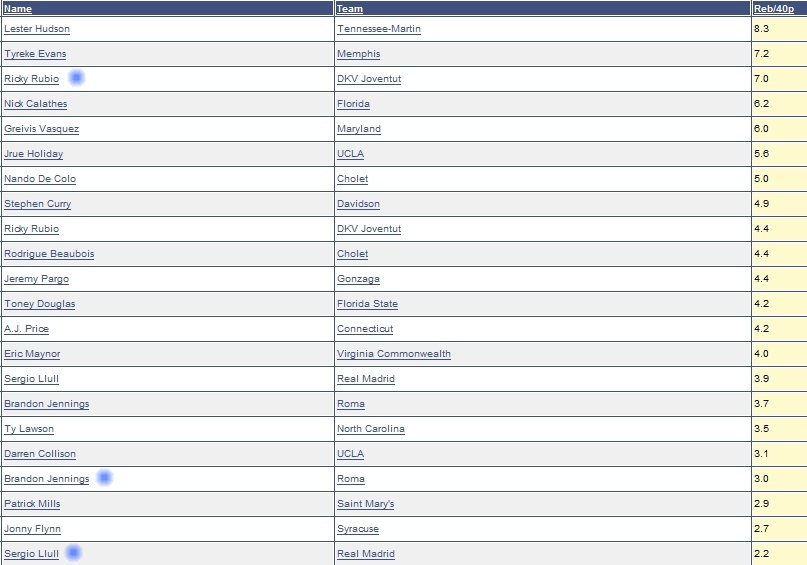
Most basketball games are decided by just a few possessions, which makes every rebound pulled down from the point guard position another small step in the direction of helping a team secure a victory. Different coaches have different philosophies on this matter, though--some absolutely insist that their point guard get back on defense immediately as soon as a shot goes up, while others give more freedom to crash the glass and come up with extra possessions. Still, we can get a decent indicator for a player's size, length, strength, athleticism and toughness by evaluating their rebounding totals, and that appears to hold true in this analysis as well.
Lester Hudson checks in as the best rebounder in this group, partially due to the level of competition he played at, but also because of his terrific length, toughness and aggressiveness. Tyreke Evans showed his superb physical profile by pulling down a very impressive 7.2 rebounds per contests, followed by Ricky Rubio's dubious Euroleague totals.
Nick Calathes showed why he was one of the college basketball's true triple-double threats with his terrific feel for grabbing rebounds, while Greivis Vasquez showed well here too. Rubios size and length shine in this stat, especially for his level of competition, while the other tall, long prospects in this group can certainly help out on the glass.
Smaller guards such as Patrick Mills, Jonny Flynn, Brandon Jennings and Darren Collison do not excel in this category.
Steals Per-40 Minutes Pace Adjusted
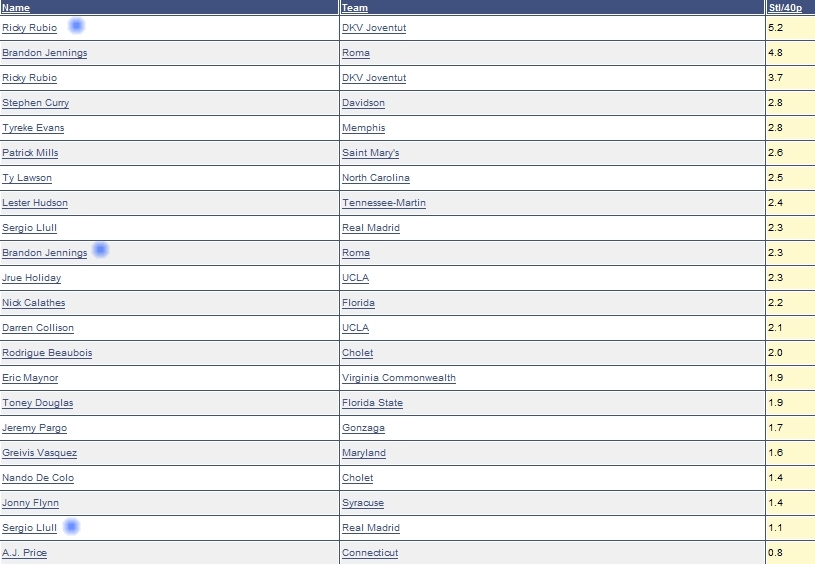
While accumulating steals doesn't always translate into being a good defender, it does appear to be a pretty good indicator of a player's physical tools, particularly his length and quickness. It also tells us a little bit about his ability to anticipate things on the floor, which is exactly where the top-ranked point guard in this draft shines the most.
Ricky Rubio is the top thief in our group, which is impressive since he did so in the top League outside of the NBA with a bad wrist. While the sample size of the Euroleague is obviously very limited, he ranks out extremely well in the ACB league as well. Brandon Jennings finishes just behind him at 4.8 steals, showing how his quickness and length complements his terrific anticipation skills.
The top NCAA thieves on our list are Tyreke Evans and Stephen Curry, two very different players who made it that high on the list for different reasons. Evans for his physical gifts, and Curry for his smarts.
Near the bottom of the list we find Jonny Flynn--who may not be getting a fair shake here considering that his team played almost exclusively in a zone. Nando De Colo, and A.J. Price may lack the quickness to create turnovers.
Blocks Per-40 Pace Adjusted
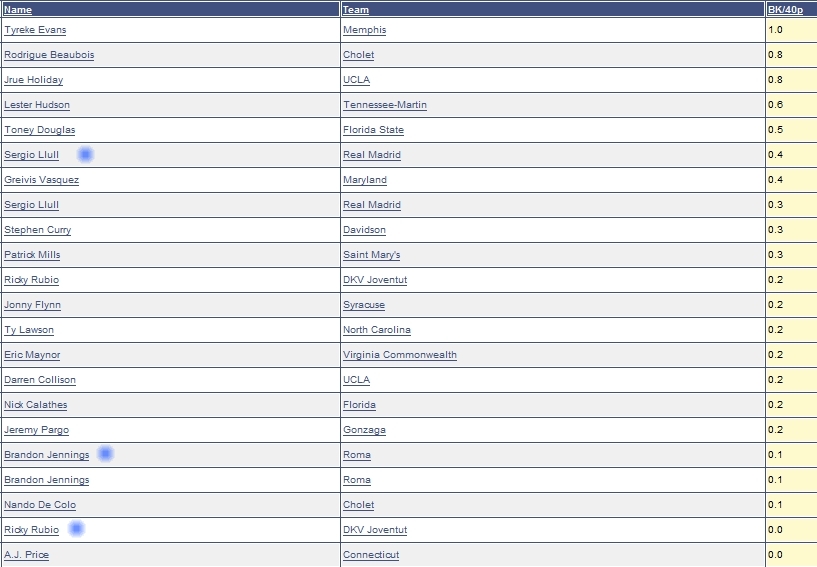
This is yet another stat that can provide some insight into the physical tools that the various point guards in this class bring to the table.
Tyreke Evans is the only player in this group blocking a full shot per-40, though Rodrigue Beaubois and Jrue Holiday utilize their length to come close to that mark. Toney Douglas is the surprise in our top-5, blocking half a shot per-game despite lacking the size of the players around him. On the low side, Brandon Jennings isnt going to reject many attempts, nor will the short arms of Eric Maynor, Nick Calathes, or Nando De Colo. A.J. Price finishes last on our list, and the lingering effects of his knee injury seem to manifest themselves here.
Team Possesions
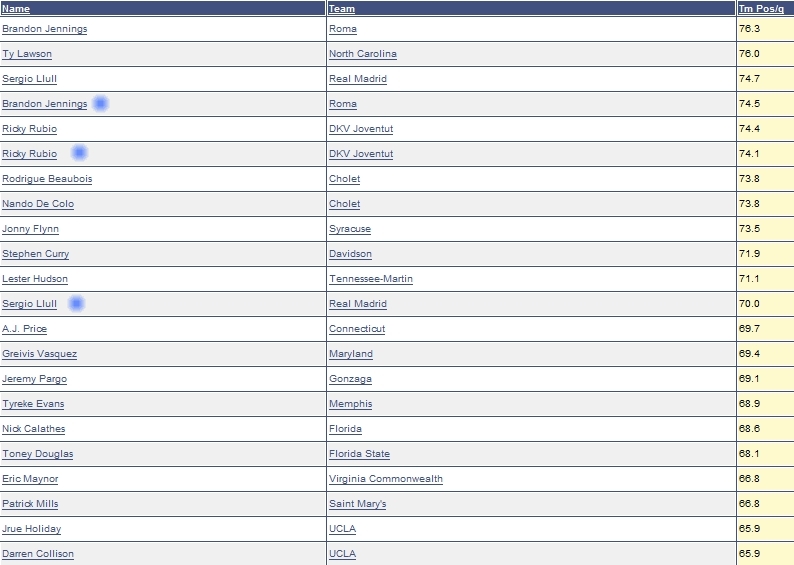
To gauge just what kind of system a player is coming from, it is important to look at some of their teams stats. Clearly North Carolina plays as fast many of the teams in Europe, which is pretty impressive, while Davidson and Tennessee-Martin posted solid marks from weak conferences. On the bottom of the heap, UCLAs system resulted in relatively less shots being taken by its players while Patrick Mills and Eric Maynor come from teams who used similarly slow paces to help mask their lack of high level talent when they matched up with superior teams.
Player Efficiency Rating
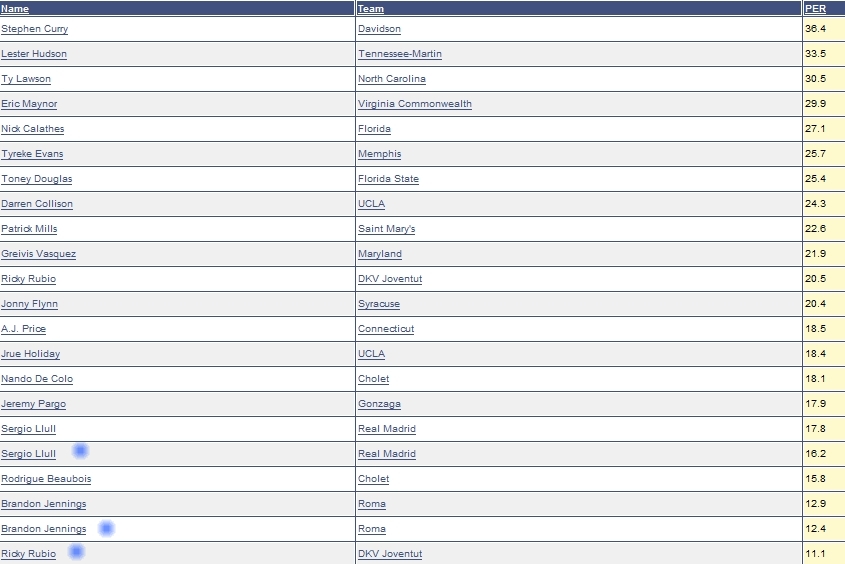
Another one of John Hollingers gems, PER is a total measure of what a player does on the floor based on more than a dozen weighted calculations. It isn't wise to compare players across different leagues, though, since an average score of 15 (the median) would be a totally different figure in another league, with its own averages. The NCAA is especially tricky considering the varying levels of competition we find in the different conferences.
Not surprisingly, Stephen Curry and Lester Hudson pace our group. Eric Maynor is in the same boat in 4th, but Ty Lawsons third place finish is the first amongst big-school players and is likely the most telling number on this list.
Near the bottom we see that the European prospects tend to have lower PERs, largely due to the smaller number of players in their league and the far higher level of competition. Rubio actually ranks 11th in his league's PER, but comes out unimpressively compared with his NCAA peers.
Jrue Holiday posted the lowest PER amongst major prospects, which is a pretty good indicator of his lack of production at UCLA this season.
Efficiency Per-40 Minutes
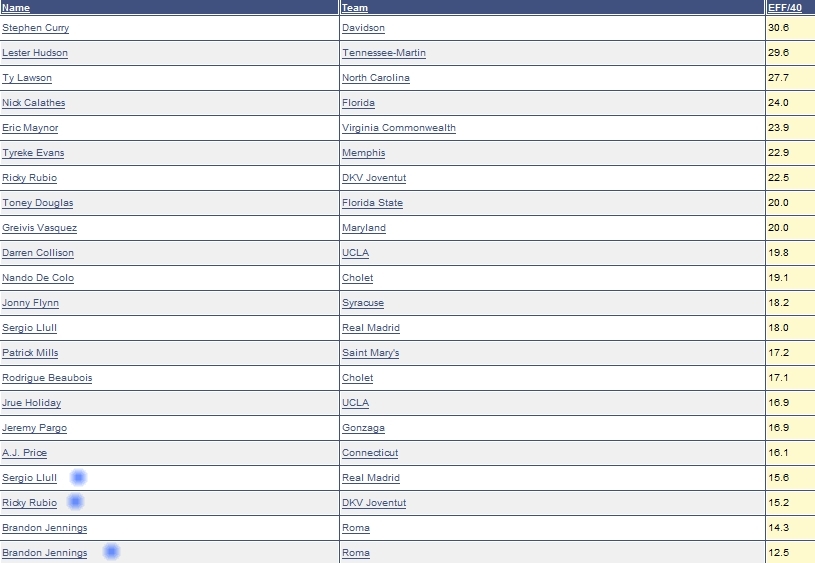
A Per-40 measure of productivity based on equally weighted stats, EFF/40 gives us some comparative opportunities that PER wasn't designed to. However, this list looks a lot like the PER rankings, but pushes Ricky Rubio and Nando De Colo up substantially, taking their league averages out of the equation and showing just how much they meant to their teams overseas.
Stat-stuffing Nick Calathes continues to show well here.













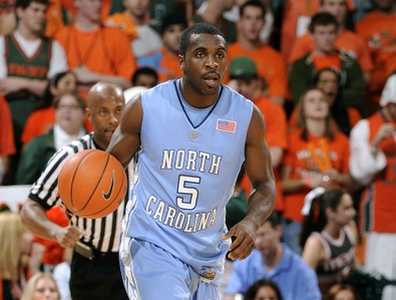































Comments